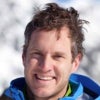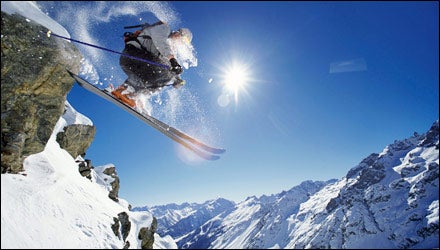The Simple Plan
A week at a ski resort is supposed to be a vacation, not a marathon. With this in mind, we asked Ann Hodel, former NCAA Division I nordic ski racer and owner of Bodywise Physical Therapy, in Boulder, Colorado, to devise a 12-week winter fitness strategy. All you have to do is augment your (hopefully) regular routine of biking or running with a few ski- and snowboard-specific exercises. The best part? If you already work out regularly, this plan should take only about three more hours per week.
The Simple Plan: Part One
Cardio
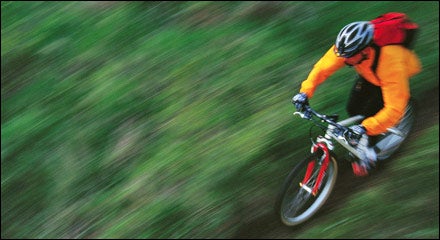
The Pacemaker
To keep track of your effort during intervals,Use a heart-rate monitor like polar’s GPS-enabled RS800G3 ($500; ). Find a flat course and run as fast as you can for a half-mile (two laps on a standard track) to a mile. Check your moniter at the end—this figure is your max heart rate.
Part One: Cardio
A good cardio base is essential if you want to ski or ride until the bullwheel’s last turn. Start with three 30-minute sessions per week, and mix up your workouts between running, biking, and swimming, as outlined here. But don’t feel like you need to do all three each week. Mix it up whenever possible, and do what you enjoy most.
TRAIL RUNNING: Besides building endurance in your calves and the quadriceps-hamstring-glute muscle complex, the great benefit of trail running is eccentric strengthening. “When you’re running downhill, you’re slowing your body weight—just as you do while skiing bumps,” says Hodel. “This strengthens your muscles by lengthening them.”
MOUNTAIN BIKING: Riding also pumps up your reactive timing—the ability to respond quickly to terrain changes and rapidly approaching objects, like trees. And, like trail running, mountain biking improves balance. “It’s a great cross-training activity for trail runners,” says Hodel, “because it requires more explosive power from the legs but has less joint and bone impact.”
SWIMMING: This complements your lower-body-intensive running and biking workouts by strengthening, stretching, and lengthening arm, chest, and back muscles. Swim with as smooth and stable a freestyle stroke as possible. Again, shoot for 30 minutes a session when you start.
THE GOAL: Increase each session’s duration by 10 percent each week for the first two months—by the end of month two, your workouts should reach an hour. If you started with three workouts per week, try to up it to four or five. As the third month begins, make one or two of your weekly sessions an interval workout. This will push your anaerobic threshold, helping your body operate at high intensity for longer stretches. Start with 30 seconds of running or biking at 85–90 percent of your max heart rate (see below), followed by two minutes of moderate-intensity activity (40–50 percent of max heart rate), for ten cycles. For each of the next four weeks, extend the length of your intervals and rest periods by 30 seconds apiece. Don’t do any other workouts on your interval days.
The Simple Plan: Part Two
Strength
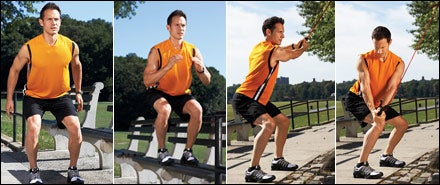
The Fuel
There are exactly three things you need to know about ski nutrition:(1) It’s all about breakfast. Start with oatmeal and fresh fruit. A little protein and fat to keep you full isn’t bad. We recommend Canadian bacon. Hot chocolate is hydrating as well as sweet. (2) Injuries usually happen in the afternoon, due to fatigue, so snack frequently. Granola bars and dried fruits provide a blood-glucose pickup to help you maintain focus. (3) Hydration is key. Insulate a warmed sports drink, and down at least 24 ounces each in the morning and in the afternoon. And try to resist the urge to slug seven beers in the hot tub: The extra fluid loss from the alcohol and sweating will hurt the next day.
Part Two: Strength
Skiing and snowboarding require strong muscles capable of explosive movement and shock absorption. Divide your strength training into upper- and lower-body workouts. Don’t ignore your chest and arms just because your legs do most of the work. Upper-body strength will give you more balance and confidence on steeps, add purpose to your pole plants, and help stave off arm injuries caused by falls. Shoot for two 45-minute strength sessions per week for the first two months. For the third month, stay at 45 minutes per session, but increase to three weekly sessions.
LOWER BODY
PLYOMETRIC JUMPS: This classic drill builds the fast-twitch muscle fibers you need to carve aggressive turns. Use a plyo-box, bench, tortoise—anything about one foot high. Stand next to it, jump onto it sideways, jump (don’t step) back down, and then explode up again as many times as you can in 60 seconds. Switch to the other side and repeat. Then face the box and jump forward onto it. Again, shoot for as many reps as possible in 60 seconds.
LUNGES: Know that feeling when your thighs feel like they’re going to burn through your ski pants? Lunges will help. Stand with legs hip width apart, hands on hips. Step forward, right leg first, lowering your pelvis until your front knee is bent 90 degrees. Then return to starting position. Do 10–12 reps, then repeat with your left leg. Lunging during runs or hikes on uneven trails will work your balance skills. As time goes on, try holding light weights—about five pounds—in your hands to increase the difficulty.
SQUATS: Nothing builds power in your quads and glutes like squats, so try to work in one session a week. Stand with feet hip width apart, with a squat bar across your trapezius muscles. Press your chest up and out. Your lower back should be slightly arched. Squat until you begin to feel your hamstrings touch your calves. Pick a weight that allows you to do three sets of 10–12 reps. Use slow, controlled movements.
UPPER BODY
CHIN-UPS: You don’t need a dumbbell rack to build a strong upper body. Start with chin-ups, and don’t be afraid to use a chin-up-assist machine. Shoot for two sets of three to six reps. Proper form: palms facing you, arms slightly wider than shoulder width and fully extended. Pull up until your chin reaches the bar. By the end of one month you should be able to do three sets; at the end of two months, three sets with less counterweight on the assist machine; and by the end of three months, you should be up to four sets with no counterweight.
PUSH-UPS: Start with two sets of 10–12 reps. Lie chest-down with your hands at shoulder level, palms flat on the floor and slightly more than shoulder width apart. Look ahead and push up. Keep your back straight. Add one set after each month.
MILITARY PRESS: Shoulder injuries happen when skiers break falls with their arms. This exercise helps strengthen the shoulder joint. Sitting with your back supported, grab a weight in each hand. Hold the weights up, squeezing your shoulder blades together so your elbows are at 90 degrees. Raise weights, then lower.
The Simple Plan: Part Three
Core
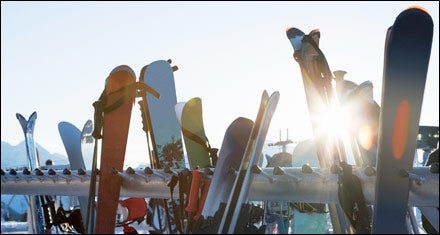
AVOID THE KNIFE
Here’s how to prevent the most common ski and snowboard injuries, according to Laura Keller, director of rehabilitation at San Francisco’s Stone Clinic. INJURY: Torn anterior cruciate ligament from backward falls. BEAT IT: Do squats and lunges to strengthen the muscles around your knee. And stay forward: Skiing from the backseat can stress your knee ligaments. INJURY: Fractured tibial plateau from increased mechanical forces generated by quicker-turning deep-sidecut skis. BEAT IT: When using new skis, start slowly: If you attempt to jam deep-sidecut skis into turns like you would straighter skis, you’ll lock them into an arc your body can’t follow. INJURY: Fractured wrist from falling onto an outstretch…
Part Three: Core
Start with three workouts per week, at five to ten minutes each (save time by doing them before or after strength sessions). For each workout, do two to three sets of the exercises below at six to eight reps each. After a month, you’ll be strong enough toincrease the reps to the 10–12 range. Add more sets as you become stronger. By the end of month three, you should be doing three sets of 10–12 reps five times per week. Each session should take 10–20 minutes.
BALL CRUNCH (UPPER ABS): Performing crunches on an exercise ball requires balance, so it’s a great workout for skiers. Lie on your back over the ball, with your spine following the ball’s curve. Slowly sit up and don’t allow the ball to roll under your hips.
CAPTAIN’S CHAIR (LOWER ABS): Grip the handholds on the captain’s chair at your gym and stabilize your back against the chair back, legs hanging down. Lift your knees in toward your chest, then return to the starting position. Don’t want to go to the gym? Do bicycles. Lie on your back, knees bent, hands clasped behind your neck. Alternately touch each elbow to your opposite knee as you bring the knee in.
CABLE WOODCHOP (OBLIQUES): At the gym, do this key core-building exercise with the cable machine. At home, use a dumbbell or elastic exercise tubing. Stand with your feet shoulder width apart, knees bent. Your right shoulder should be next to the pulley on the cable machine, or the tree or wall where you’ve attached the tubing. Grab the handle with both hands and rotate to the left and down. When your hands reach your left thigh, reverse the motion. Do all reps on one side, then switch sides.
Ski and Snowboard Gear
The Essentials
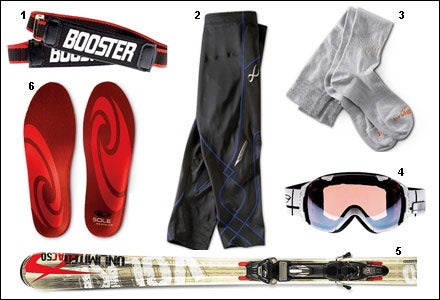
Ski Boot
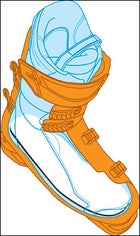
THE SEASON’S BEST PERFORMANCE-ENHANCING GEAR
1. Booster’s aftermarket bootstrap helps alleviate shin bang and increases your boot’s shock absorption in cruddy snow. $28; 2. CW-X’s Stabilyx compression tights provide more support than regular long underwear, and this three-quarter-length model won’t bunch up around your boots. $86; 3. Because they’re better at wicking moisture and letting the liners insulate, ultrathin socks like Bridgedale’s Micro Fit are warmer than they appear. Plus, they don’t get compressed into the soft tissue of your feet, like thick socks do. $20; 4. Of all the goggles we tested for this year’s Winter Buyer’s Guide, Smith’s frameless I/O had the best clarity and peripheral vision. $160; 5. Völkl’s Unlimited AC50 skis, one of our favorite all-mountain types, come with Marker’s new, integrated Motion iPT Wide Ride binding system, which is 30 percent wider than conventional bindings. This translates to wicked power transfer to the skis’ edges. $1,175; 6. Simply adding a heat-moldable, semi-custom footbed like Sole’s Regular Softec can dramatically improve the fit and comfort of your boot. $45;
Fit Tight
Boots that fit well transfer energy to your skis smoothlyand boots that don’t fit well hurt. So every serious skier should get his boots professionally fitted. Here, Bob Remiger, of the Boot Doctors, in Taos Ski Valley, New Mexico, dishes on how to do it right.
BUY SMART Find a shop that’s certified by America’s Best Bootfitters (), an organization of independent fitters.
GET A TIGHT FIT Most new skiers buy oversize boots because they feel good at first. Then the liner packs out. Buy a snug boot. If one area is too tight, a good boot fitter can fix it.
STRETCH THE SHELL If your boot fitter determines that the shell plastic is causing a pressure point, he’ll either grind or heat and stretch the shell to modify it.
GET A CUSTOM FOOTBED Stock footbeds don’t provide much support, since they’re made to fit a wide range of foot types. A custom-built footbed, like Superfeet’s Kork Vac ($120; ), will keep your foot bones stacked in the strongest possible anatomical position.
GET SIZED Your boot fitter will have you put your bare foot into a shell with the liner removed. Slide your foot forward until your toes touch the front. If the fitter can put his index and middle finger between your heel and the shell, the size is correct.

